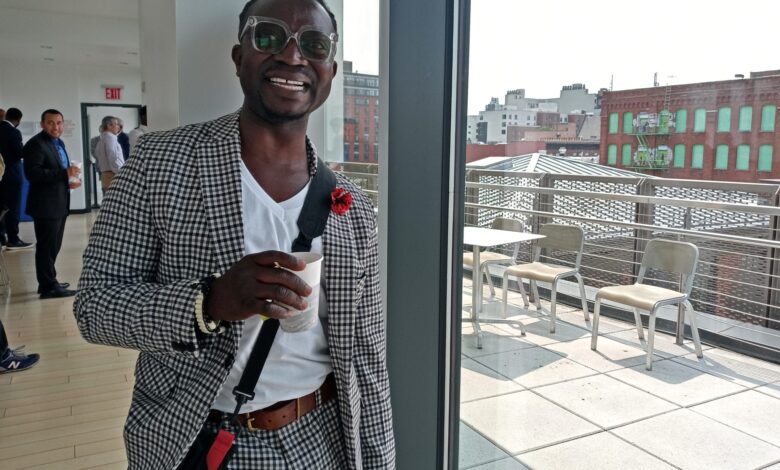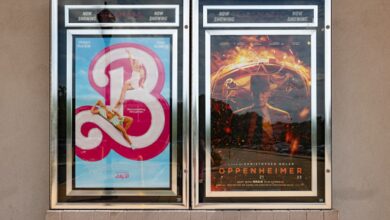Spread love it’s the Brooklyn way

The Economy League of Greater Philadelphia’s leadership exchange program brought Philly’s finest to Brooklyn Navy Yard to explore urban development and economic inclusion.
On a humid Friday morning in mid-June, as commuters began their last day of an early summer work week, some key Brooklyn power brokers in equitable economy-making opened their books of knowledge to a collective of movers and shakers from Philadelphia. More pointedly, the Brooklynites shared how extreme financial times call for the most innovative measures.
This is where the Economy League of Greater Philadelphia (the Economy League) enters into the discourse. An organization committed to tackling some of Philly’s most dire issues, its Greater Philadelphia Leadership Exchange (GPLEX) program organized a trip between the two cities’ influencers to “build civic muscle and bring more economic opportunity” to the City of Brotherly Love.
At 108 years old, the Economy League is, indeed, long in the tooth. Leaning to the accurate adage, “with age comes wisdom,” the GPLEX event deviated from its normal enterprise of gathering 100-plus folk. Rather, the planners carefully selected a few dozen decision-makers who intimately explored ways to design a thriving metro area teeming with resources and prospects as it is in talent, purpose and profound collaborative efforts.
“We mix[ed] a cross-sector [of] leaders who [were] good networkers and [could] take part in conversations that can help to inform projects and make improvements in the Philly region,” Kiersten Mailler, GPLEX’s director, told Ark Republic.
What many do not know: GPLEX is more of a verb than a noun. It actively encourages leaders to trade ideas through interactive, multi-day visits to cities across the U.S. The process is similar to an ethnographer conducting fieldwork. Meaning, attendees are as much observers as they are participants. Overall, the goal is for GPLEX delegates to collect and take back ideas that expand their urban development work. For the Brooklyn trip, the first site of exploration was an almost forgotten shipyard that blossomed into a viable economic stalwart.
When they reminisce over you . . .
Before the power-meeting took place, the Philly assemblage’s ride from the host hotel allowed them to snatch quick glimpses of some Brooklyn neighborhoods. Sleepy brownstones in different variations of upkeep dotted the landscape alternating between mom-and-pop shops. When the GPLEX group drove up to the perimeter of the Brooklyn Navy Yard (the Yard), evidence of how the now-industrial park shared similar pasts with their navy yard in Philadelphia percolated.
The Yard houses one of the oldest naval stations in the country. Yet, a Philadelphian will remind you that their hometown was the first of six sites commissioned by a young America to serve as a naval base.Also being one of the initial ports budgeted in by the Department of Defense, Brooklyn was part of the country’s efforts to beef up a thinly outfitted Navy, and increase the U.S. presence in global mercantilism.
With 160 ships built—some of them being important battleships since the Civil War—the Yard, at its peak during WWII, employed over 70,000 people. The former military station, spanning a little over 300 acres, played a critical role for civilians who used the site as a viable establishment of themselves both economically, and as Americans.
When mid-20th century deindustrialization was at full speed, the U.S. military began to downsize its physical operations domestically. Subsequently, Defense Secretary Robert McNamara ordered its closing along with several hundred sites in 1966. Following the Yard’s shuttering as a naval base, New York City purchased the area. Using a nonprofit corporation, they ran private commercial enterprises, with much of it initially being shipbuilding. However, overtime, that would not be enough. Philadelphia’s naval yard (the Navy Yard) also met the same fate.

At the turn of the 19th century, when the U.S. had yet to hit three decades as a nation, the government bought waterfront real estate in Philadelphia. Hence, launching the first naval base on Front Street docks in 1776. There, the workers would also launch the first warship, the USS Franklin.
At its height, the Navy Yard employed 60,000 laborers inside its facilities along with another 30,000-plus working off of its grounds. For generations, the U.S. Navy was the city’s biggest employer. But like Brooklyn, it was on the chop block along with hundreds of other navy yards starting in the 1960s. However, Philadelphians fought like hell to keep the site operational.
A major lawsuit and years of protests later, the federal government finally decommissioned the waterfront gem in 1996. It then officially transferred the property to the City of Philadelphia in 2000, running it through the non profit, Philadelphia Industrial Development Corporation (PDIC).
Watch | Closing: How gentrification led to losing Brooklyn’s last machine shop
Forging a series of strategies to turn the Navy Yard into a civilian commercial enclave, state and local officials started with saving its shipbuilding capability by brokering a deal with a private firm. Later, the focus was to turn the 1,200 acre property into mixed-use real estate.
Over the decades, both Philadelphia and Brooklyn ports struggled to keep their dockyards afloat. For years, many akin properties went unused and in need of remediation in certain areas. While each kept a shipbuilding legacy, the signs of the changing times were unavoidable. Both experienced damages due to the fall of U.S. manufacturing, along with white flight, then the Reagan Era, and followed by the gutting of inner cities that experienced several raging drug epidemics.
Philadelphia, like Brooklyn, went through multiple waves of economic downturns. Notwithstanding, the development at Brooklyn’s Navy Yard has outpaced Philadelphia’s.
“The work that they’ve done at the [Brooklyn] navy yard is transformational,” said Steven Scott, the principal senior client executive at Bradley & Bradley Associates, an insurance company in the Pennsylvania metropolis. “[Philadelphia] has a great yard. The foundation is there, but I would love to incorporate more non-profits and more businesses of color, more African American firms.”
Gradually, the Navy Yard is reconstructing its old bones to accommodate an integrated, multi-use space housing restaurants, corporate digs and public art. Most notably, it is home to popular confectionery Tasty Baking Company behind the TastyKake desserts bakery; and popular retailer, Urban Outfitters. As well, the PDIC has opened the space for scientific research. Yet and still, the area has much more room to evolve.
In 2022, the PDIC released a 20-year master plan, the Navy Yard’s third proposal in the last several decades. This time, it promises residential buildings, more green spaces, and a boost in employment opportunities. It also made a promise to dedicate a certain number of business opportunities to under-represented companies. Nevertheless, how does one get there? Especially in a city with a sordid history of the segregation of resources, representation and racial treatment.
“We really need to take a more progressive attitude with development and think about how to integrate more marginalized populations and also small businesses in the city’s larger economy,” David Ortiz, chief impact officer at True Access Capital said during the tour.
True Access Capital is a community development financial institution (CDFI) that works with businesses and entrepreneurs in the Philadelphia metro region. It was one of the organizations at the exchange that was looking to “think outside of traditional banking” for implementable answers that could make the city’s industries more representative of its population–folk of color.
Like its tradition of shipbuilding, the Yard’s evolution has spanned over 200 years in Brooklyn. Indeed, there is still much to be done to ensure ample opportunities exist for local business, and underrepresented entrepreneurs. Nonetheless, the work done in the borough offers a template for coastal cities using their waterfronts as a multifaceted revenue-generating machine.

Milkshake brings all the boys to the Yard
So there we were on a smoggy Friday morning, looking at renovated buildings in the Yard as we snaked around its privately-maintained and environmentally-friendly roads. In spite of the smoke from Canadian wildfires limiting the views of New York’s skyline, the pristine condition of the buildings at the Yard stood out.
Since its construction in the late 1800s, the Yard in Brooklyn has gone through a number of metamorphoses. While it still uses dry docks, its frigate operations mainly focus on commercial ship repair. Today, the multi-commercial complex serves as a critical economic center for NYC.
Tucked in between the Williamsburg, Clinton Hill and Fort Green neighborhoods, along the East River, the Yard mostly consists of commercial spaces where over 500 businesses coexist. Taking up 50 of its acres is Steiner Studios.
Located at the site of the old Brooklyn Naval Hospital, it is the second largest film and television production studio complex outside of Hollywood after Tyler Perry Studios. With 30 soundstages and plans to construct eight more, the studio shows that Brooklyn simply went back to its roots.
The American film industry started in New York. From about 1895 to approximately 1910, NYC hailed itself as the capital of film productions before it moved out west. The film industry was a natural progression from a robust ethnic theater scene dominated by Jewish, Italian, French and Negro productions. Today, Steiner Studios represents the return of a coveted history, and a concentrated site for employment opportunities.
Carrying a legacy of performing and visual arts, literature, as well as the birthplace of the American record industry, Philadelphia is familiar with entertainment. When the collective found out about the work at Steiner, some saw the potential in Philly. “With all of the arts and culture we have in Philadelphia, and all of the television shows and movies already being filmed in Philadelphia … we are primed to make the city a hub for the filming industry,” said Thomas Young, senior associate of Bellevue Strategies.
Phildalphia is one of the singing capitals of the world—from blues to jazz to doo wop to the “Philly sound,” and even to hip hop. Most notably is the role that the city played in introducing pop music while filming on location with the highly popular television show, American Bandstand. Still, you can catch a great musical performance in the many modest-sized venues across the metro, which solidifies its rich musical influences. But, for film, there is much more work to do.
As the home of Comcast NBCUniversal, a broadband, mobile and entertainment conglomerate, the city can easily position itself as an alternative to Hollywood’s silver screen. With the industry currently in the midst of a serious labor strike, what has resulted are concerted efforts to create cheaper productions. Unfortunately, at the expense of writers and smaller actors. Nonetheless, therein lies a silver lining with the growing video-film industries and film-to-stream productions that create more projects than Hollywood.
Today, Philly is re-emerging as a coveted urban playground, but it has some serious infrastructure work to complete in order to compete with the big screen. According to the Greater Philadelphia Filmmakers Program, there were about 400 productions that were completed annually prior to the pandemic. That said, much of that stopped during the global crisis. As well, other nearby cities have been wooing film productions with generous tax credits, such as Newark, New Jersey. Yet and still, the massive landscape and different scenery from urban to green, in addition to an impressive waterway, can bring the deals to the Navy Yard in particular.
Sustainability: investing in the future
Superstorm Sandy in 2012 was a blip in climate history for most, but it was a rude environmental awakening for New Yorkers. During the category three hurricane, 30-foot waves from the Upper New York Bay slammed against the banks of the Yard, resulting in power outages and serious flooding. Once the volatile water settled, it became evident that human development taxed the once flourishing ecosystems of the boroughs.
Green initiatives were fundamental in rebuilding NYC after Superstorm Sandy. A climacteric phase of redevelopment was to build its eroded shorelines from Coney Island to Brooklyn. The answer was to restore the coasts by building oyster reefs. At the Yard, the Billion Oyster Project along the Wallabout Basin hosts a spawning sanctuary heartily co-maintained by Brooklyn STEAM Center (BSC) high school students. An educational program for juniors and seniors, it trains those interested in pursuing careers in manufacturing and technology.
Maintaining the marina project cultivating oysters is a hands-on project preparing them to enter the workforce with experience and skills. “It’s really dope how the navy yard in Brooklyn is so self sufficient to the point where they have high school students and they have those career pathways for them to get trained, earn money and then eventually have a full time job at the navy yard,” said Carlos Aponte, the founder and executive director of We Love Philly.
The oyster reefs are one of many sustainability efforts at the Yard. From energy star roofs to Rideshares using low emission vehicles, and stormwater managed roads, the Yard carefully constructs with its environmental footprint in mind.

C.R.E.A.M. – Capital Rules Everything Around Me
The pinnacle of the Yard stopover ended with a panel discussion. For an hour, five power brokers detailed successes and challenges of their work in one of the most competitive markets in the nation. Since much of the difficulty experienced by smaller companies is in accessing capital, the intertwining theme during the roundtable was brokering financial equitability by any means necessary.
Lindsay Greene (Brooklyn Navy Yard Development Corporation), Eleni Delimpaltadaki Janis (Equivico), Shari Suchoff (Brooklyn Communities Collaborative), Juan Adorno (JPX Capital Consulting) and Nancy Carin (Business Outreach Center Network) offered creative solutions to tackling generations of exclusion. More specifically, how they have been disrupting the narrow restrictions of investment banking for marginalized entrepreneurs.
“In the name of equity, we’re going to show some love by sharing our perspective,” Adorno welcomed GPLEX participants. Because time is money, he quickly ushered in the conversation with a question to his co-panelists about the most complex aspects of what they do, and the best strategies practiced towards solving them.
For Carin, the heart of neighborhood growth and stability are in underserved businesses receiving improved economic prospects. She recalled assisting a group of fashion designers in Fort Green with a purchase order from Macy’s. It was their largest undertaking at the time, but they met a significant barrier. What they needed was hard cash to purchase materials and other operational costs to carry them while they worked on the goods.
In response, the Business Outreach Center Network provided a contract financing loan to float them. That means they used what they would receive in the purchase order as collateral. What Carin learned was that behind every remedy in business, is another issue. “Getting a contract doesn’t mean they’re going to get paid,” she reflected. “Doesn’t mean they’re going to know how to perform in that new environment.”
While the loan offered temporary relief, the fickle nature of business could not guarantee that they, nor future debtors, could pay off the loan. As a leader of a community financing institution, Carin saw businesses who could carry out services, but needed to tweak their management of operations or to boost marketing plans. Others could expand their businesses substantially if they acquired the right licenses and permits.
Alternative issues she cited when helping small ethnic businesses, especially those whose native language is not English, is them understanding the contacts and their stipulations. One Spanish-speaking company almost signed a contract that would eliminate all of their non-union employees, who were crucial in their business.
By and large, the overarching urgency was to advocate for entrepreneurs in ways when banking institutions and loan boards began nitpicking. Moreover, they wanted stellar portfolios for ventures they already knew faced a plethora of impediments that left them out of many market opportunities in the first place. “Our loan committee wants to dig into their financial statements and balance sheets … it’s [really] about if they could perform the work.”
The irony in a post-George Floyd, post-pandemic economy is that the old way is not working; to the point that a simple upgrade is inefficient. That is why Greene, the CEO of the Brooklyn Yard nonprofit, often finds herself in the weeds of the industry. “A lot of the higher value contracts . . . [such as high tech] we don’t find a lot of Black and Brown companies,” informs Greene. “You have to think about these companies because it is expensive to bid on city contracts . . . then the government pays slowly, so you have to float until you get paid.”
While many times, “contracts [are] the first step, financing is critical,” emphasized Carin. It could be the business deal that sets a company up to compete, or be able to pay their workers on time and in full.

Low risk, high rewards
According to the Small Business Administration (SBA), small businesses–typically, privately-owned companies with less than 500 employees–make up 99.9 percent of American enterprises. But in the big leagues, the modest-sized ventures have been relegated to the nosebleed section of finance. The issue is that many venture capitalists see small business investments as taking higher risks. The experts say they are wrong.
During the panel discussion, Janis, a managing partner at Equivico, reveals that the gravest mistakes made by venture capitalists is them overlooking the small business sector. “We know there is an unmet demand for a small commercial loan . . . of about $87 billion dollars,” she explained. “There is [an] extraordinary opportunity to bring more capital to market and finance small businesses.”
According to Janis, the missed moments to deploy capital to companies that will more than likely make profit is because “the investors . . . are a few steps removed from small businesses and from financing.” They even ask Janis “is this real financing?” More problematic, many could care less about impact, or think that financing a business that works on a social problem is “politicizing investing.”
The attitude for many in these predominantly white and male spaces is that doing business with small establishments, especially those that are Black and Latino, is not doing actual business. Rather, it is a philanthropic effort at best. “We have uncovered a market that my peers don’t know,” said Janis after she mentioned how Black women have the highest numbers in startups.
The investment blindspots contrast the often used facts by the U.S. government who touts how small businesses are the backbone of the economy. Since 1995, small businesses created almost 63 percent of net jobs. “Nobody’s paying attention, nobody’s looking at the data on the success rate of small businesses,” Eleanor Sharp ruminated after the conversation. Sharp, who works in Philadelphia’s city planning office furthered that the “failure of loans” from companies of color are “miniscule, but they’re being charged like they’re a heavy risk . . . there’s the bias.”
So why is this section overlooked? “They didn’t want to track the progress in the first place,” according to Carin. Diversity remains an abstract concept that many believe can be satisfied with a generous grant and a few backpack giveaways at the beginning of the school year. While some companies began to survey if diversity and inclusion strategies worked, others merely mention it in a paragraph on a website, possibly during MLK holiday, Juneteenth and Cinco De Mayo.
For Greene, securing better representation is a long game she bets on daily. One way she does that is securing the services of firms that are rarely on a golf course brokering big deals. “You want to get Black, Brown and women firms in your retainer [agreements], and that gets them some stability and allows them to continue and grow based on their capability rather than just job-by-job.”
So insightful were the presenters, the GPLEX audience had to be dragged out of the room. “What all of them said resonated with me, especially Lindsay,” reflected Keola Harrington, Senior Director of Finance for the City of Philadelphia. “Even though you have a high position, you’ve got to know what is going on at every level to have institutional change.”
We all walked away from that meeting in so much thought that the bus was rocking in conversation during our unpacking. When we realized it was mid-day, our next stop would fill our bellies as much as it would satisfy our curiosity in community building.

This is part two of a four-part series of shadowing a group of Philadelphia leaders who traversed to Brooklyn to see what they could learn to bring back to the City of brotherly love at a moment of expansion and redevelopment in a post-pandemic urban America. This series is sponsored by The Economy League of Greater Philadelphia and the Knight-Lenfest Local News Transformation Fund.





